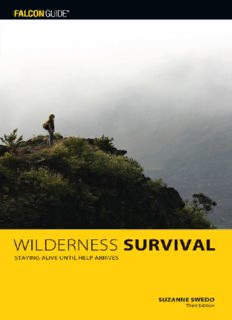
Wilderness survival : staying alive until help arrives PDF
Preview Wilderness survival : staying alive until help arrives
Wilderness Survival Wilderness Survival STAYING ALIVE UNTIL HELP ARRIVES Third Edition Suzanne Swedo FALCONGUIDES GUILFORD, CONNECTICUT HELENA, MONTANA For Rex An imprint of Rowman & Littlefield Falcon, FalconGuides, and Outfit Your Mind are registered trademarks of Rowman & Littlefield. Distributed by NATIONAL BOOK NETWORK Copyright © 2016 by Rowman & Littlefield Illustrations by Todd Telander All rights reserved. No part of this book may be reproduced in any form or by any electronic or mechanical means, including information storage and retrieval systems, without written permission from the publisher, except by a reviewer who may quote passages in a review. British Library Cataloguing-in-Publication Information available Library of Congress Cataloging-in-Publication Data available ISBN 978-1-4930-1734-8 (paperback) ISBN 978-1-4930-1735-5 (e-book) The paper used in this publication meets the minimum requirements of American National Standard for Information Sciences—Permanence of Paper for Printed Library Materials, ANSI/NISO Z39.48-1992. The author and Rowman & Littlefield assume no liability for accidents happening to, or injuries sustained by, readers who engage in the activities described in this book. Contents Acknowledgments Introduction Using This Book 1 Before You Go 2 The Ten or More Essentials 3 How Not to Get Lost 4 If You Get Lost 5 Survival Priorities and First Aid 6 Shelter from Cold and Heat 7 Starting an Emergency Fire 8 Water Emergencies 9 Food Emergencies Conclusion Appendix: Checklists About the Author Acknowledgments Special thanks to Ron Hood for reviewing the manuscript and for striking the spark, to Brad Childs at the Wilderness Institute, Melinda Goodwater and Singaman Lama of Goodwater’s Adventures, Jim Lowery of Earth Skills, and Steve Tabor of Desert Survivors. I appreciate help from the National Outings Program of the Sierra Club and to the organizers of the Angeles Chapter of the Basic Mountaineering Training and Wilderness Training Course. Thanks to Kylie Chappell at the Yosemite Conservancy. For assistance in the field, special thanks to John Alder-son, Betty Berenson, Craig Deutsche, Laura Lathrop, Fumiaki Nakamura, and Rex Raymer. Introduction Most backcountry travelers set out into the wilderness for recreation, love of nature, or self-discovery and to experience the sense of freedom that comes from breaking out of the technological and social cocoon that feeds and shelters them —and separates them from the natural world. That freedom has a price, however. Wilderness, by definition, is a place without easy access to the facilities and services established to keep people out of trouble or rescue them when they get into it. In the wilderness you are on your own and expected to be both mentally and materially self-sufficient. Most wilderness areas in North America are under the jurisdiction of some public agency—such as the USDA Forest Service, the National Park Service, Parks Canada, or the Bureau of Land Management—that is equipped to help people in emergencies. These agencies recognize that accidents can happen to even the most skilled and experienced outdoorspeople. Still, such agencies are usually understaffed and underfunded and already busy enough protecting the wilderness from destruction by visitors rather than the other way around. Many national parks, for example, which formerly conducted helicopter rescues for free, are now forced to charge victims for the service, and a very expensive service it is. Electronic devices like cell phones, GPS, or personal locator beacons to summon help in emergencies can be valuable under certain circumstances, but should never be thought of as substitutes for careful planning, preparation, and know-how. They may strain to the limit the resources of search-and-rescue organizations, many of which are staffed by volunteers. They can and sometimes do fail, can be dropped, broken or drowned. They depend on batteries. Most depend to some degree or other on an unobstructed patch of sky to reach satellites or cell phone coverage. If you find yourself at the bottom of a shaded gully, you might be out of luck. Remember too that if you do manage to get an SOS out, you will still have to keep yourself alive and safe until help can reach you, possibly a period of hours or even days if you’re in a remote area. That is not to say that electronic devices have no place at all in the backcountry; they can be handy and fun, but they should never be used as substitutes for personal responsibility.
Description: